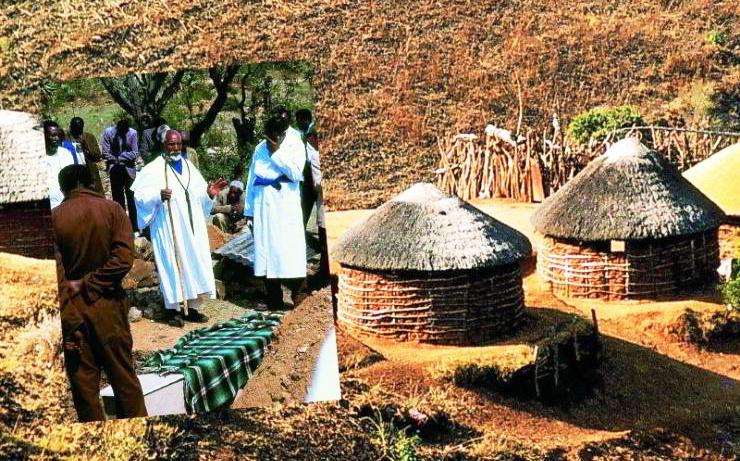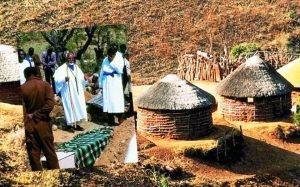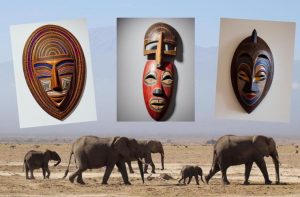In Africa, a tomb is more than a pit in which a dead body has been buried; it is first and foremost a house, a place of rest. It is the place of contact between the living and the dead.
The Ngoni people of Malawi bury their kings in a sitting position, indicating that they are still ruling, and that the tomb is their palace. Those who thank the gravediggers often speak of them as having built the house of rest.
In Uganda, the word ‘kasendi‘ (meaning ‘the place of suffering’) is used by the Alur people to refer to a graveyard, probably alluding to the decomposition of the body or the negative effects of death. However, the grave is generally spoken about in positive terms.
Among the Baganda, though, the graveyard is viewed ambivalently. It is kiggya. This name is a form of Luggya (compound).
There is a transition from the lu-na class to the ki-bi class. While the living resides in luggya, the dead remain in kiggya, a negative or ugly type of luggya, which nevertheless is revered, kept jealously, and mentioned proudly in genealogies. As for the grave itself, it is called magombe, representing the spiritual aspect of the ntaana, the very pit in which the body is laid, serving as the gateway to the underworld. Magombe, in fact, is the underworld, the domain of the ancestors.
In some African cultures, those who dig the grave usually have a special connection to the village chief, the deceased, or their clan. All these points relate to the sacred nature of the grave. Sometimes, it is the chief who designates the location where the grave should be dug. If there is a rock in the subsoil of the chosen spot and the tomb cannot be dug with simple tools, it is interpreted that the deceased has rejected that place.
The grave diggers are often rewarded with local beer, a cock, or a goat. These three offerings are connected to the ancestors. The rules associated with grave digging, such as the prohibition against going into the grave with shoes on, must be strictly observed, and a solemn report must be made to the authorities once the grave is ready. The tools are thoroughly cleaned, and the grave diggers perform an ablution as a sign of purification.
It is interesting to see everything that was found in the soil, which was removed while digging the grave, like stones, tree roots, etc., is inserted back into the soil covering the grave. It is as if they are already contaminated by death.
The grave is sacred even before the body is put in it. Some tribes bury their dead in houses or right in the compound to show that even in death, the person remains attached to the family as a life-giving spirit and the family will look after the grave as a sign of care for the deceased.
We can understand why sedentary people are very reluctant to leave or sell the land where they have buried their dead. If they cannot avoid leaving the land, they take his/her bones or their symbols with them to the new place.
There is a well-known taboo about exhuming the bones of the dead. It is done at night, and very few people attend it. Those who participated in the first burial do not participate in the second one. Normally, the human person is buried once; if there is to be a second burial, it is secret and exceptional. Steps have to be taken to appease the deceased in question.
The graveyard, being the village of the deceased, is not only connected with death but also with life. This is why it is taboo to go to the graveyard without permission, especially at night. This taboo comes from the fear that one can use witchcraft or even magic to stop the flow of life, to turn the ancestors into enemies of their descendants
Some people have the habit of putting shoes on top of the tomb. These people often bury their dead by the roadside. In fact, such people are still migrating, and they want their dead to follow them.
The tomb is the place of contact between the living and the dead. Libations are poured on the tomb as a kind of sacrifice to the spirit of the deceased, but also as a sign of communion with the dead. Its ambivalence comes back when one considers the fact that the day the deceased was lowered into the grave, that was the last time they were last seen in the physical/social world yet even the great grandson/granddaughter who did not see them will be brought there to see their grandparent and to receive blessings from them.
In Africa, every physical entity has a spiritual counterpart, as every spiritual entity has a spiritual counterpart or support. The tomb is the physical support of the spirit of the deceased, who rests and whose dwelling is well located.
A life well-lived is marked by a tomb. This is why witches, wizards, and stillborn babies are not buried properly, and those who commit suicide have no tombs; it is as if they never lived.
A tomb is a sign of identity. It faces the direction from which the people to whom the deceased belonged came from. The reason is that death is a return to the ancestors, and the tomb is the gateway to the underworld, which is their domain.
Africans believe that life comes from God, through the ancestors (the dead) to the living. The graveyard, being the village of the deceased, is not only connected with death but also with life. Stories about planting charms or gris-gris on graves with this intention are common in African villages. Tombs should be respected, kept clean, and well-protected. (Edward Kanyike)







